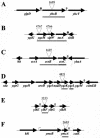Genes involved in formation of structured multicellular communities by Bacillus subtilis
- PMID: 15175311
- PMCID: PMC419949
- DOI: 10.1128/JB.186.12.3970-3979.2004
Genes involved in formation of structured multicellular communities by Bacillus subtilis
Abstract
The spore-forming bacterium Bacillus subtilis is capable of assembling multicellular communities (biofilms) that display a high degree of spatiotemporal organization. Wild strains that have not undergone domestication in the laboratory produce particularly robust biofilms with complex architectural features, such as fruiting-body-like aerial projections whose tips serve as preferential sites for sporulation. To discover genes involved in this multicellular behavior and to do so on a genome-wide basis, we took advantage of a large collection of mutants which have disruptions of most of the uncharacterized genes in the B. subtilis genome. This collection, which was generated with a laboratory strain, was screened for mutants that were impaired in biofilm formation. This subset of mutated genes was then introduced into the wild strain NCIB 3610 to study their effects on biofilm formation in liquid and solid media. In this way we identified six genes that are involved in the development of multicellular communities. These are yhxB (encoding a putative phosphohexomutase that may mediate exopolysaccharide synthesis), sipW (encoding a signal peptidase), ecsB (encoding an ABC transporter subunit), yqeK (encoding a putative phosphatase), ylbF (encoding a regulatory protein), and ymcA (a gene of unknown function). Further analysis revealed that these six genes play different roles in B. subtilis community development.
Figures









Similar articles
-
A master regulator for biofilm formation by Bacillus subtilis.Mol Microbiol. 2005 Feb;55(3):739-49. doi: 10.1111/j.1365-2958.2004.04440.x. Mol Microbiol. 2005. PMID: 15661000
-
Targets of the master regulator of biofilm formation in Bacillus subtilis.Mol Microbiol. 2006 Feb;59(4):1216-28. doi: 10.1111/j.1365-2958.2005.05019.x. Mol Microbiol. 2006. PMID: 16430695
-
Effects of phosphorelay perturbations on architecture, sporulation, and spore resistance in biofilms of Bacillus subtilis.J Bacteriol. 2006 Apr;188(8):3099-109. doi: 10.1128/JB.188.8.3099-3109.2006. J Bacteriol. 2006. PMID: 16585769 Free PMC article.
-
Thinking about Bacillus subtilis as a multicellular organism.Curr Opin Microbiol. 2007 Dec;10(6):638-43. doi: 10.1016/j.mib.2007.09.006. Epub 2007 Oct 30. Curr Opin Microbiol. 2007. PMID: 17977783 Free PMC article. Review.
-
A complex path for domestication of B. subtilis sociality.Curr Genet. 2015 Nov;61(4):493-6. doi: 10.1007/s00294-015-0479-9. Epub 2015 Feb 14. Curr Genet. 2015. PMID: 25680358 Review.
Cited by
-
The comER Gene Plays an Important Role in Biofilm Formation and Sporulation in both Bacillus subtilis and Bacillus cereus.Front Microbiol. 2016 Jun 28;7:1025. doi: 10.3389/fmicb.2016.01025. eCollection 2016. Front Microbiol. 2016. PMID: 27446060 Free PMC article.
-
Novel mechanisms of controlling the activities of the transcription factors Spo0A and ComA by the plasmid-encoded quorum sensing regulators Rap60-Phr60 in Bacillus subtilis.Mol Microbiol. 2015 Apr;96(2):325-48. doi: 10.1111/mmi.12939. Epub 2015 Feb 18. Mol Microbiol. 2015. PMID: 25598361 Free PMC article.
-
Functional microdomains in bacterial membranes.Genes Dev. 2010 Sep 1;24(17):1893-902. doi: 10.1101/gad.1945010. Epub 2010 Aug 16. Genes Dev. 2010. PMID: 20713508 Free PMC article.
-
Collective Vortex-Like Movement of Bacillus subtilis Facilitates the Generation of Floating Biofilms.Front Microbiol. 2018 Mar 29;9:590. doi: 10.3389/fmicb.2018.00590. eCollection 2018. Front Microbiol. 2018. PMID: 29651280 Free PMC article.
-
Redox-driven regulation of microbial community morphogenesis.Curr Opin Microbiol. 2014 Apr;18:39-45. doi: 10.1016/j.mib.2014.01.006. Epub 2014 Mar 5. Curr Opin Microbiol. 2014. PMID: 24607644 Free PMC article. Review.
References
-
- Aravind, L., and E. V. Koonin. 1998. The HD domain defines a new superfamily of metal-dependent phosphohydrolases. Trends Biol. Sci. 23:469-472. - PubMed
Publication types
MeSH terms
Substances
Grants and funding
LinkOut - more resources
Full Text Sources
Other Literature Sources
Molecular Biology Databases

